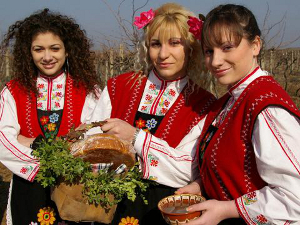Trifon Zarezan - The Day of Love & Wine

In the month of February Bulgarians celebrate wine and its patron Saint Trifon, also known as Trifon Zarezan. Wine-makers and Vine-growers love Trifon Zarezan so much that its popularity has now ensured the event is celebrated in accordance with both the old and the new religious calendars. Whilst the old calendar states the date of February 1st as the day of Trifon Zarezan, over the last 15 years, February 14th has also become a day on which the event is celebrated thus providing an excuse for many people to celebrate it twice in the matter of weeks.
February 14th is well known across the world as the day of St Valentine, which coupled with Trifon Zarezan gives the people of Bulgaria the choice of whether to celebrate wine or love, or even both, on the same date.
The celebrations that take place on the day of Trifon Zarezan mark the meeting point of the ending of winter and the nearing of spring. The period between these two seasons are when the weather is usually at its most fierce which is why during this crossover, rituals are performed to ensure a triumph of vitality and fruitfulness. The first pruning of the vines for the season is the main activity performed on February 14th, when people gather in the vineyards outside the villages. Only men are allowed to prune the vines, however women are not totally deprived of partaking in the holiday ritual. Women get up early in the morning, bake festive breads decorated with dough vines and grapes, roast a hen stuffed with grits (baked ground corn kernels), and put these all with a flask of wine in a woolen bag before seeing their men to the gate. Women also knead special round loaves - a symbol of the fertile field, and generously hand them out to neighbours and relatives. Before heading to the vineyards the men go to the holiday church service and collect a musician to bring with them to the vineyards.
When stepping into his vineyard, every man looks up at the rising sun and makes the sign of the cross three times. He then cuts three twigs from three different vines and washes the cut places with red wine, holy water and ashes from wood burnt on Christmas Eve. While pruning, everyone whispers blessings, wishing for an abundant harvest later in the year. The pruned twigs are twined into wreaths that men put on their hats, shoulders, or flasks, or take home to display.
The men then go to the fruit-trees which did not bear fruit in the winter and ritually threaten to cut them down. Another participant in the ritual then promises that next spring the trees will once again be fruitful so they should be spared from destruction. During the festivities, men pick up three live coals from their hearth. These symbolise the invigorating power of the fire and the sun. Looking at the coals, people try to foretell which crops will yield the most abundant harvest in the new season.
Once the pruning is complete, the men gather in the vines to eat, drink, sing and dance. In the evening they become guests in the `King's' house. The King is the man who harvested the most grapes and made the best wine in the previous year. It is a tradition that the King and his `subjects' must get drunk that evening to secure an abundant harvest for the upcoming season.
There are many different versions as to how the name Trifon Zarezan came about but one of the most popular stories is that Trifon, just like the villagers, once had a vineyard. One day, when he was pruning his vineyard, the Virgin Mary passed by. Trifon laughed at her because she did not know who the father of her child was, so she condemned him to cut his nose with his pruning shears. From then on, people called Trifon `Zarezan' (the `snub-nosed'). Even the icons depict St Trifon with pruning shears in hand, showing him to be honoured as a patron of vineyards- one of the main symbols of fertility in Bulgarian folklore culture.
